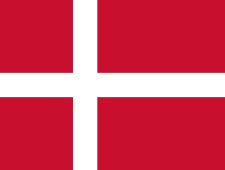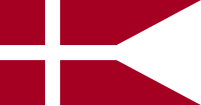
Back Vlag van Denemarke Afrikaans علم الدنمارك Arabic علم الدنمارك ARZ Bandera de Dinamarca AST Danimarka bayrağı Azerbaijani Danėjės vieleva BAT-SMG Сцяг Даніі Byelorussian Сьцяг Даніі BE-X-OLD Национално знаме на Дания Bulgarian ডেনমার্কর ফিরালহান BPY
 | |
| Use | Civil flag and ensign |
|---|---|
| Proportion | 28:37 national[1][2] 56:107 royal |
| Adopted | 15 June 1219 (Dannebrog legend) 1625 (recognised as national flag)[3] |
| Design | A white Nordic cross with a red background |
| Rigets flag—Flag of the Kingdom [of Denmark]; also known as Splitflaget | |
 | |
| Use | State flag and ensign, war flag |
| Proportion | 56:107[2] |
| Orlogsflag | |
 | |
| Use | Naval ensign |
| Proportion | 7:17[2] |
| Adopted | 11 June 1748 |
The national flag of Denmark (Danish: Dannebrog, pronounced [ˈtænəˌpʁoˀ])[4] is red with a white Nordic cross, which means that the cross extends to the edges of the flag and the vertical part of the cross is shifted to the hoist side.
A banner with a white-on-red cross is attested as having been used by the kings of Denmark since the 14th century.[5] An origin legend with considerable impact on Danish national historiography connects the introduction of the flag to the Battle of Lindanise of 1219.[6] The elongated Nordic cross, which represents Christianity, reflects its use as a maritime flag in the 18th century.[7] The flag became popular as a national flag in the early 16th century. Its private use was outlawed in 1834 but again permitted by a regulation of 1854. The flag holds the world record of being the oldest continuously used national flag, that is since 1625.[3]
- ^ Regulation of 11 June 1748.
- ^ a b c Cite error: The named reference
encyklopædienwas invoked but never defined (see the help page). - ^ a b "Oldest continuously used national flag". Guinness World Records. Retrieved 2023-11-10.
- ^ The word Dannebrog is recorded since the 19th century, and in the opinion of A. D. Jørgensen ("Om Danebroges Oprindelse", Historiske Afhandlinger 2, 1899) the word may be of medieval coinage. Old Danish brog continues Old Norse brók "piece of cloth; breeches, trousers"; the word is not now current in Danish outside of composition, the Ordbog over det danske Sprog (1920 edition) listed it as "dated or poetic" (foræld. og poet.) for "trousers".
- ^ "Dannebrog" by Hans Christian Bjerg, p.12, ISBN 87-7739-906-4.
- ^ Andrew Evans (2008). Iceland. Bradt. ISBN 9781841622156. Retrieved 2007-12-31.
Legend states that a red cloth with the white cross simply fell from the sky in the middle of the 13th-century Battle of Valdemar, after which the Danes were victorious. As a badge of divine right, Denmark flew its cross in the other Scandinavian countries it ruled and as each nation gained independence, they incorporated the Christian symbol.
Inge Adriansen, Nationale symboler, Museum Tusculanum Press, 2003, p. 129: "Fra begyndelsen af 1400-tallet kan Dannebrog med sikkerhed dokumenteres som rigsflag, det vil sige statsmagtens og kongens flag" (English: "Dannebrog can with certainty be documented as flag of the realm, that is the flag of the authority of state and of the king, from the beginning of the 1400s") - ^ The medieval flags displaying crosses can be traced to the crusades and were later used as representing saints (as in the St George's Flag), the cross representing Christianity
Jeroen Temperman (2010). State Religion Relationships and Human Rights Law. Martinus Nijhoff Publishers. ISBN 978-9004181489. Retrieved 2007-12-31.
Many predominantly Christian states show a cross, symbolizing Christianity, on their national flag. Scandinavian crosses or Nordic crosses on the flags of the Nordic countries–Denmark, Finland, Iceland, Norway, and Sweden–also represent Christianity.
. The elongated cross design was subsequently adopted by other Nordic countries: Sweden, Norway, Finland, Iceland, and the Faroe Islands, as well as the British archipelagos of Shetland and Orkney.
© MMXXIII Rich X Search. We shall prevail. All rights reserved. Rich X Search